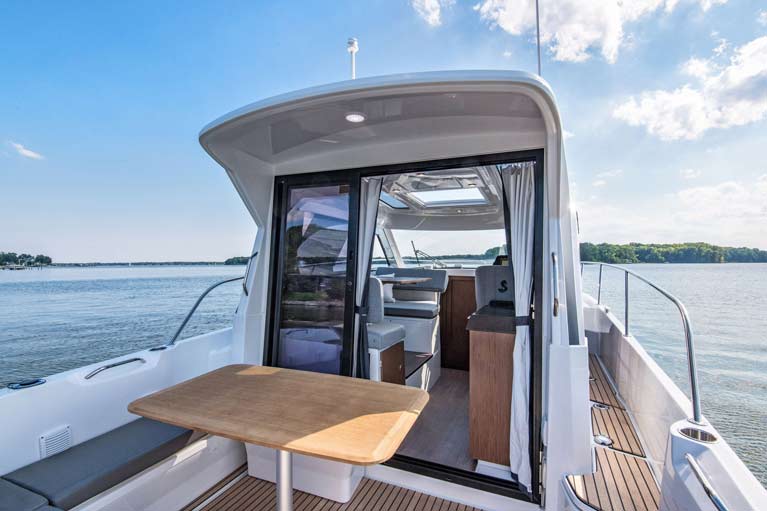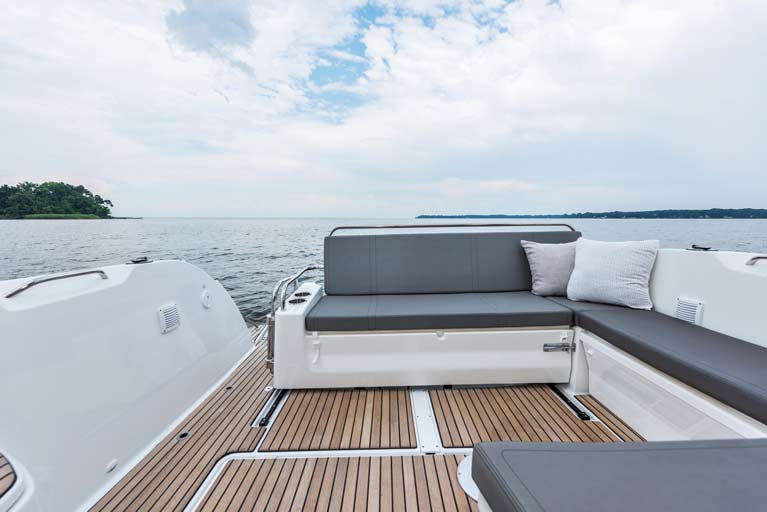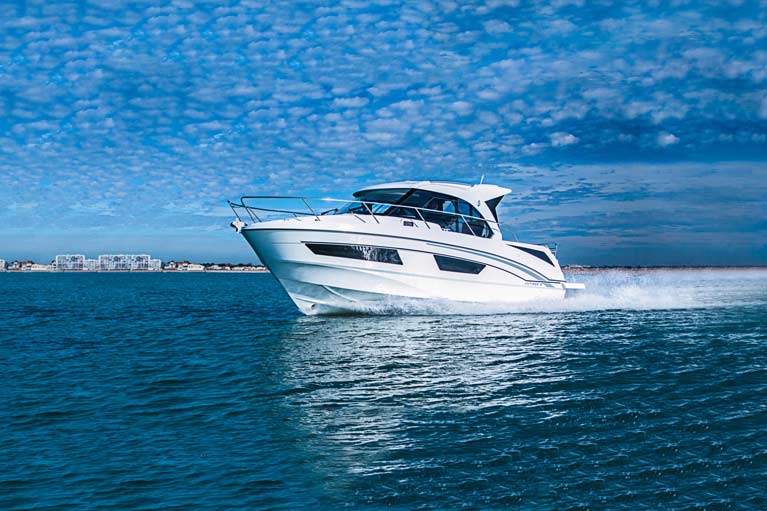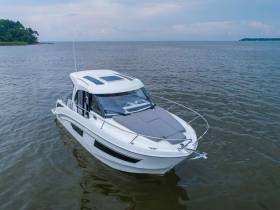Displaying items by tag: Antares
Explore Irish Waters in Style with the Antares Outboard Range from Beneteau - Available Now at BJ Marine
The biggest growth area for boating in Irish waters in recent seasons has been on outboard cruisers, and the Antares range from Beneteau has delivered massively, writes BJ Marine General Manager James Kirwan.
Whether for day boating, fishing, coastal cruising or just pure adrenaline rushes, the Antares range can do it all. The fact that these boats all have sliding glass doors to shelter from our changeable climate has made them the perfect option to get afloat.
With the 2024 season kicking off at BJ Marine, we have each model from 7m to 11m available immediately! In the last 12 months, we have handed over Antares boats on every Irish coast, north, south, east, and west, as well as on the Shannon, and we are in a position to deliver even more with trade-in opportunities always available.
The Antares 11 Fly is powered by twin Suzuki 300hp outboard engines and has magnificent specs, including a bow thruster, heating, electronic pack, teak cockpit, cockpit enclosure, and so much more! We have a 2022 build, a 2023 model with less than 10 hours on the engines and a saving of over €100k on the new list price. Afloat in Greystones and available at €279,000 inc vat., get in touch to step aboard and plan your season afloat
 The Beneteau Antares 9 from BJ Marine
The Beneteau Antares 9 from BJ Marine
The Antares 9 is powered by twin Suzuki 200hp engines, and its two-cabin configuration makes the nine the perfect family weekend. We have a 2023 demo model available, which is currently on display at our Cardiff office but is available to be delivered anywhere in Ireland.
 The Beneteau Antares 8 from BJ Marine
The Beneteau Antares 8 from BJ Marine
The Antares 8 and Antares 7 are also Suzuki-powered but single-engined, with 200hp on the Antares 8 and 150hp on the Antares 7. We sold our full 2023/24 allocation of these models but managed to secure an extra unit for each, and they will be arriving by truck at our Greystones head office next week.
 The Beneteau Antares 7 from BJ Marine
The Beneteau Antares 7 from BJ Marine
For full pricing and specification details, please get in touch with our team at [email protected] or call the office on 01 2878334. Our website is www.bjmarine.net
The New Antares 9 sets the stage for an exciting future of outboard-sports-cruisers from Beneteau writes David Hoctor of Irish agents BJ Marine
Both the largest and sportiest Antares outboard to date, this is the model that bridges the gap to the heavier and more expensive inboard sports cruisers.
This is the perfect boat for the couple or family who want a life onboard. With two completely private double cabins, fully useable galley and generous shower and head, this boat is more than comfortable for weekends and holidays on the water. With engine power up to 400hp and fuel tanks up to 600L, she has the autonomy and sea keeping for extended adventures like no boat of her kind before.
 The wheelhouse saloon has a large expandable table with opposing seats to either side. The forward seat-rest swings back to allow the seat to face forward, so that 2 people can sit alongside the helm while underway
The wheelhouse saloon has a large expandable table with opposing seats to either side. The forward seat-rest swings back to allow the seat to face forward, so that 2 people can sit alongside the helm while underway
 The stylish galley comes as standard with twin gas cooker, large contemporary stainless steel sink, cup holders along one side and a large black glass lid folds down to act as a work surface and to protect the galley.
The stylish galley comes as standard with twin gas cooker, large contemporary stainless steel sink, cup holders along one side and a large black glass lid folds down to act as a work surface and to protect the galley.
BASIC PRACTICAL INFO
The maximum length with all options fitted is exactly 9 meters. Her beam is just 2.95m and weighs well under 4.5t when loaded. Her massive cockpit, with almost 40 square foot of space and seats that convert to a sunbathing area, is the ideal place to relax with family and friends, sunbath and share meals. Or you can store everything away and clear the large cockpit for a fishing trip.
2 spacious double cabins and the convertible saloon seating, allows comfortable sleeping space for 6 adults to overnight. A large galley with gas stove and the generous toilet on shower make it a boat that would easily accommodate four people for a weekend or a weeks holidays.
LAYOUT
The newly developed hull on both the new 9-metre Beneteaus has allowed for a maximisation of space on board, giving her the comforts and features of much bigger boats.
–Cockpit
The Antares 9 has the familiar U shaped seating in the cockpit, but with some clever innovations. The main aft bench slides forward to allowing the seating to remain in use while the engines are up and you’re relaxing on the marina. The second benefit of this is to open up the transom and swim platform area to allow easier access across and around the transom of the boat.
The cockpit seating area easily converts to a massive sunpad that fills the space.
 The fully glazed sliding door
The fully glazed sliding door
–Interior
The fully glazed sliding door opens the saloon and galley onto the cockpit seating/sun lounging area. The wheelhouse saloon has a large expandable table with opposing seats to either side. The forward seat rest swings back to allow the seat to face forward so that 2 people can sit alongside the helm while underway.
 Sun lounging area
Sun lounging area
Across from the seating area a long galley with a slick black glass top stretches along the starboard side of the boat to the helm. The stylish galley comes as standard with twin gas cooker, large contemporary stainless steel sink, cup holders along one side and a large black glass lid folds down to act as a work surface and to protect the galley while underway.
Below deck is a large owner’s cabin with double bed, large aft cabin with a double bed and a spacious head and shower room.
OPTIONS
When choosing the spec for your new Antares there are many extra options. One of the three trim level packs may give you all you need, depending on how you plan to use the boat.
 The Antares 9 has an Airstep hull
The Antares 9 has an Airstep hull
PERFORMANCE
- HANDLING
The Antares 9 splits the waves with her sharply angled lower bow and sits solidly on the surface of the water thanks to patented Beneteau Airstep®2 Hull innovation.
This system of channelling air through grooves on the sides of the bow back under the boat creates a stream of air between the surface of the boat and water to stabilise the boat and improve performance and economy. With the added options of the zipwake auto-trim system and a bow thruster, this boat takes care of all difficult driving situations with ease.
- SEA TRIAL
Our sea trial boat was fitted with 2x200hp Suzuki APX. Maxed out with the engine trimmed she was smooth at 38kts. Cruising at 20knts she’s only burning 51Lp/h giving you a range of well over 300km with plenty of reserves. Her incredibly responsive Suzuki engines got her on the plane in 3.6 seconds.
RANGE
The Antares 9 OB is certified to take 10 people in category C. For more adventurous voyages she is rated to take 6 people in category B, which means offshore adventures and almost limitless coastal cruising possibilities.
PRICE AND AVAILABILITY
The Antares 9 has been sold out since her launch over a year and a half ago. At the time of writing, the next available orders are for January 2020. However, there are a few opportunities left to get on the water this season.
WHERE TO BUY
BJ Marine has one Antares 9 with a great spec available and ready to get you on the water for the 2019 season, as well as many other opportunities across the Beneteau power and sailboat range.
Contact BJ Marine today to discuss options for a Beneteau Antares 9 or any of the Beneteau range.
BJ MARINE Cardiff +44 29 2070 7331
BJ MARINE North Wales +44 1758 612686
BJ MARINE Belfast +44 2891-271434
BJ MARINE Dublin +353 1 287-8334





























































